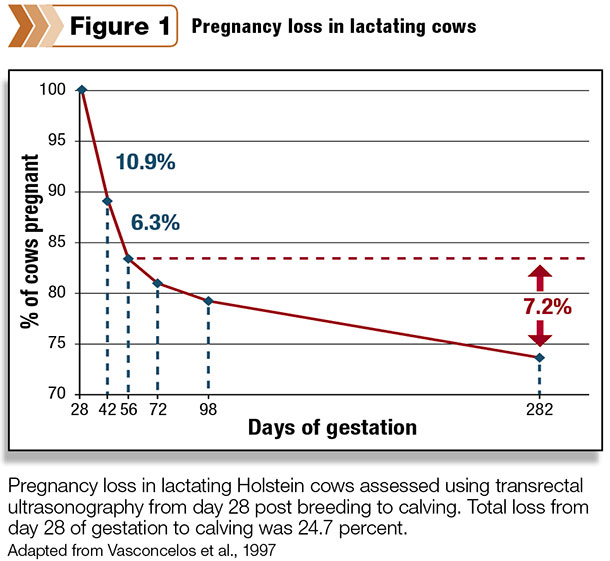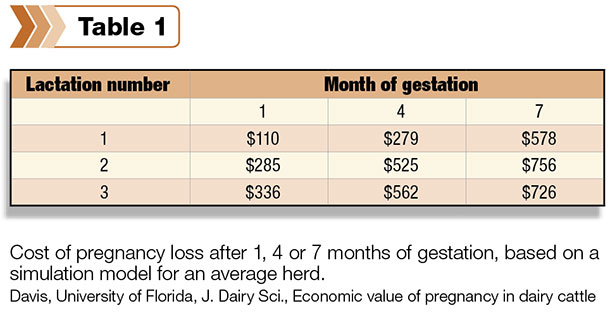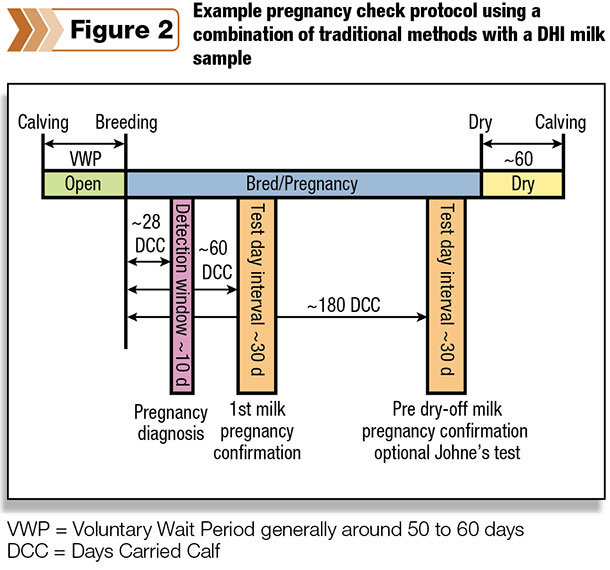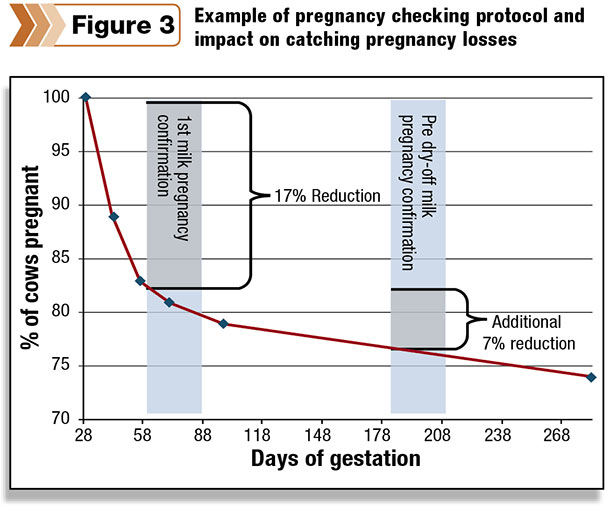An effective cow and heifer breeding program is key to maximizing your long-term profitability. Extended calving intervals can quickly lead to lower overall production and higher reproductive culling rates, which is why it is important to identify open cows as swiftly and accurately as possible. Adding a milk-based pregnancy test to the pregnancy checking protocol may be the tool to do just that.
Although reproductive technologies and management practices have improved reproductive performance, challenges can sometimes disrupt a good breeding program. The summer of 2012, for example, tested performance due to an extended period of temperatures above 90ºF coupled with high heat indices.
Challenges getting cows pregnant and maintaining pregnancies were observed in large parts of the U.S. that typically experience few problems. Although the results in terms of lower pregnancy rates and higher pregnancy losses weren’t immediately observed, these did become apparent during the spring of 2013, when many Midwestern herds saw lower numbers of cows calving.
In retrospect, most herds did a good job getting cows bred and checking for initial pregnancies. However, not all producers perform follow-up pregnancy confirmation checks later in gestation to ensure cows are still pregnant.
Although skipping later-gestation pregnancy checks saves labor and cost in the short run, if a herd is experiencing higher pregnancy loss rates, it can lead to undetected open cows that will generally show up at dry-off time. With the introduction of the milk pregnancy test several years ago, there is a simple, cost-effective method to determine if a cow is still pregnant.
Pregnancy losses
Producers wish to determine as quickly as possible if a breeding resulted in a pregnancy. With current technologies, many producers determine initial pregnancy as early as 28 days. The question then becomes how many of these cows maintain their pregnancy past the 28-day gestation window?
Figure 1 shows research measuring pregnancy losses after 28 days in gestation. As observed in this study, most losses (17.4 percent) occurred in the 28-to-56-days-in- gestation window. After 56 days in gestation, the rates by which losses occurred slowed down; however, there is still a 7.2 percent loss observed before 283 days in gestation.

Losing a pregnancy later in gestation has a significant economic impact. Table 1 illustrates research results from Davis showing the simulated costs of a pregnancy loss based on lactation number and stage of gestation. As a loss is observed later in gestation, the resulting economic loss increases significantly. Cows in their second or greater lactation see even greater losses.

While the risk for a pregnancy loss decreases throughout gestation, the economic loss increases. The question becomes: How quickly can one determine a cow lost her pregnancy?
Assuming initial pregnancy determination occurs at approximately 28 days in gestation, using data from Figure 1 and setting up a protocol performing a follow-up pregnancy check by around 56 days in gestation would catch the majority of pregnancy losses. A late-lactation pregnancy check prior to dry-off at around 210 days in gestation would catch any late losses.
Using a milk pregnancy test
With the introduction of milk pregnancy testing nearly two years ago, a new convenient method is now available to producers and veterinarians to check for initial pregnancies and follow up confirmatory tests on the milking herd.
The milk pregnancy test can be run using a preserved DHI milk sample collected on test day, or the producer can strip cows and collect a small amount of milk and send this to a laboratory that can conduct the milk pregnancy test.
In most cases, the laboratory can return results within one business day from when it received the milk sample. The milk pregnancy test can be run after 60 days fresh and as early as 28 days after breeding. Depending on volume, the cost is generally between $3.50 and $5 per sample.
To use the milk pregnancy test, it is key that the producer, in consultation with the veterinarian, establishes a protocol that best suits the individual farm’s needs. An initial determination of pregnancy by the veterinarian with follow-up testing using a DHI milk sample is a very cost-effective option. If collecting a weekly milk sample with a quick turnaround in a diagnostics lab is an option, then a pregnancy check for cows 28 to 35 days bred using a milk sample is possible.
Figure 2 shows an example of a protocol that can be employed using a monthly DHI milk sample in combination with other methods of pregnancy determination like palpation, ultrasound or a blood sample. In addition to using the milk sample for pregnancy check, a Johne’s test can also be conducted using the same milk sample, creating even greater returns from the milk sample.

As shown in Figure 3, if a monthly DHI milk sample is available, then confirmatory testing at 60 to 90 days in gestation and prior to dry-off at 180 to 210 days would catch the majority of pregnancy losses. Figure 3 shows the combination of the observed pregnancy loss rates shown in Figure 1 and the protocol described above (Figure 2).
Summary
Data shows increased use of milk pregnancy testing in Midwest herds. Producers without regular access to a veterinarian may find the milk pregnancy test a cost-effective method to determine and confirm pregnancies. Herds using clean-up bulls or those with pasture-bred cows may also find the milk pregnancy test a cost-effective alternative to sort pregnant cows from open cows and focus the veterinarian’s time on the open cows.
Producers should pay close attention to pregnancy loss rates throughout the year. These losses may be seasonal with greater losses observed in the summer months. Depending on the observed loss rates, conducting one or two confirmatory pregnancy checks later in gestation can more quickly identify cows that lost their pregnancy and minimize the associated economic losses from a longer calving interval and reduced milk production.
With lower projected milk prices, profit margins on a single cow will most likely be smaller, which makes it even more important to catch open cows quickly and, depending on her stage of lactation and production level, decide if the cow will be bred or sold. PD
References omitted due to space but are available upon request. Click here to email an editor.

Robert Fourdraine
Vice President - DHI Operations
AgSource Cooperative Services







